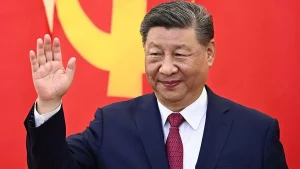Blog
China’s Xi Urges Vietnam to Resist ‘Bullying’ Amid Trump’s Tariff Threats
As global trade tensions escalate, Chinese President Xi Jinping has called on Vietnam to stand together against “unilateral bullying,” a clear reference to U.S. trade policies under President Donald Trump. Xi’s remarks, made during a visit to Hanoi, come as part of a broader Southeast Asia tour aimed at strengthening regional alliances in the face of looming U.S. tariffs.
Xi’s Southeast Asia Charm Offensive
Xi’s trip to Vietnam, the first leg of a tour that includes Malaysia and Cambodia, is strategically timed. The U.S. recently imposed 145% tariffs on Chinese imports, prompting Beijing to retaliate with 125% tariffs on American goods. While Trump paused tariffs of up to 46% on Vietnam last week, the uncertainty of future U.S. trade actions has put Southeast Asian nations on edge.
In Hanoi, Xi met with Vietnam’s Communist Party Secretary-General To Lam and Prime Minister Pham Minh Chinh, emphasizing the need to “jointly oppose unilateral bullying” and uphold the global free trade system. According to Chinese state media Xinhua, Xi urged Vietnam to strengthen strategic resolve to protect industrial and supply chains. His visit culminated in the signing of 45 cooperation agreements, including deals on rail projects and supply chain enhancements, signaling deeper economic ties.
Xi’s messaging paints China as a reliable partner in contrast to what he portrays as U.S. unpredictability. “There are no winners in trade wars,” Xi wrote in Vietnam’s Nhan Dan newspaper, warning against protectionism. This narrative aligns with his broader goal of positioning China as a defender of global trade rules while the U.S. pursues an “America First” agenda.

Trump’s Tariff Gambit and Vietnam’s Balancing Act
The U.S.-China trade war has placed Vietnam in a delicate position. As a manufacturing hub, Vietnam relies heavily on exports to the U.S., which account for 30% of its GDP. At the same time, China is Vietnam’s largest trading partner, with bilateral trade nearly doubling between 2017 and 2024. Chinese investments have poured into Vietnam as manufacturers shift supply chains to avoid U.S. tariffs, making Hanoi a key player in global trade dynamics.
Trump has accused Xi’s meetings with Vietnamese leaders of being a ploy to “screw the United States,” reflecting his skepticism of multilateral engagements. Speaking from the Oval Office, he claimed not to blame China or Vietnam but suggested their discussions focused on undermining U.S. interests. Despite a U.S. customs notice exempting smartphones and computers from tariffs, Trump later clarified on social media that these goods were simply moved to a different tariff category, adding to global confusion.
Vietnam, wary of appearing too aligned with China, is treading carefully. Susannah Patton of the Lowy Institute noted that Vietnam will “manage the perception that it is colluding with China against the United States,” given the U.S.’s importance as an export market. Hanoi has also agreed to crack down on Chinese goods transshipped through its territory to the U.S., hoping to avoid future tariffs.
A Broader Regional Strategy
Xi’s tour is about more than Vietnam. In Malaysia, he is expected to meet the king and Prime Minister Anwar Ibrahim, while Cambodia will host him later in the week. These visits aim to solidify China’s influence in Southeast Asia, a region increasingly vital to global supply chains. For instance, Malaysia’s U Mobile recently announced it would use Chinese firms Huawei and ZTE for its 5G network, underscoring China’s technological reach.
Analysts see Xi’s diplomacy as a calculated move to exploit uncertainty caused by Trump’s tariff policies. Stephen Olson, a former U.S. trade negotiator, called it a “shrewd tactical move,” noting that Xi is positioning China as a stable partner while painting the U.S. as a “reckless rogue nation.” However, tensions linger, particularly over South China Sea disputes, where Vietnam and China have clashed in the past.

What’s at Stake?
The escalating U.S.-China trade war threatens to disrupt global markets, with Southeast Asia caught in the crossfire. For Vietnam, balancing relations with both powers is critical to sustaining its economic growth. Xi’s visit, marked by flag-waving crowds and symbolic gestures like a wreath-laying ceremony at the Ho Chi Minh Mausoleum, underscores China’s intent to deepen ties with its neighbor.
As Trump mulls further tariffs, Xi’s call to resist “bullying” resonates with countries wary of U.S. protectionism. Yet, Southeast Asian nations remain cautious, aware that alienating the U.S. could invite economic retaliation. The region’s future hinges on navigating this high-stakes rivalry without becoming collateral damage.
 Skip to content
Skip to content

